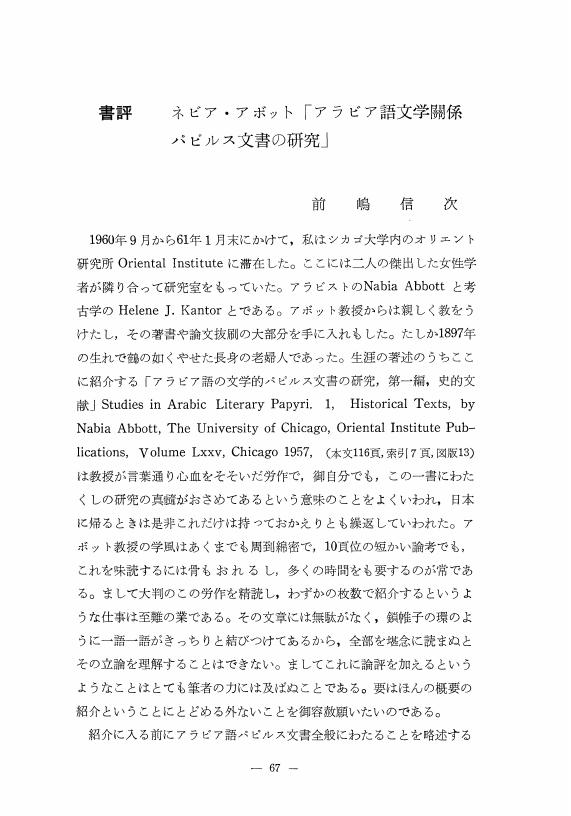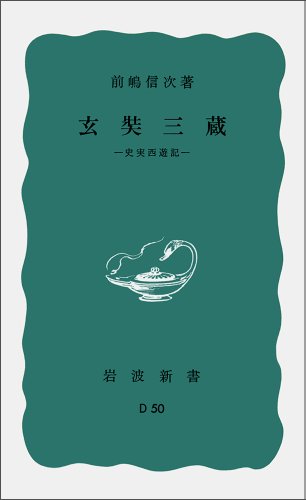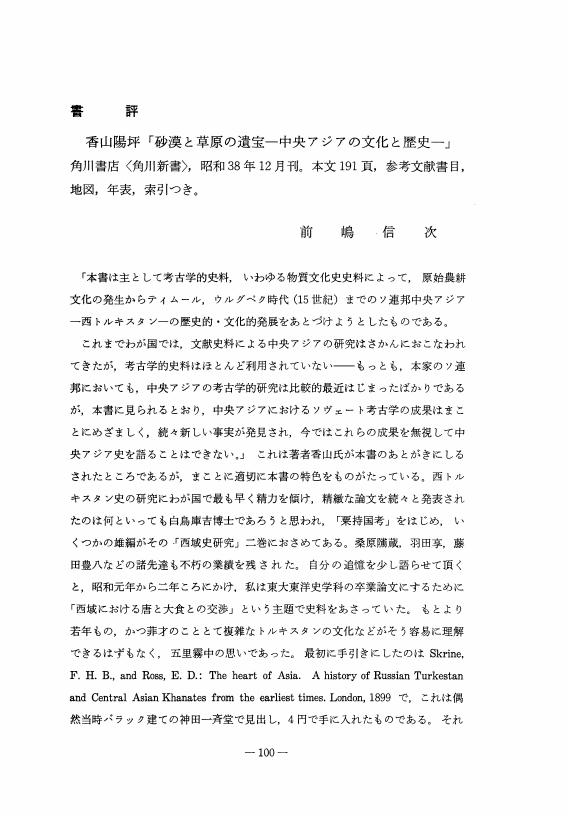4 0 0 0 IR 日持上人の大陸渡航について(上) : 宣化出土遺物を中心として
- 著者
- 前嶋 信次
- 出版者
- 慶應義塾大学
- 雑誌
- 史学 (ISSN:03869334)
- 巻号頁・発行日
- vol.29, no.4, pp.365-405, 1957-03
序言一 その經歷二 その門出について三 大地を球形と知りしか四 宣化と立化寺
4 0 0 0 OA リチャ・ード・バートンとその千夜一夜の訳業
- 著者
- 前嶋 信次
- 出版者
- 一般社団法人 日本オリエント学会
- 雑誌
- オリエント (ISSN:00305219)
- 巻号頁・発行日
- vol.16, no.1, pp.97-126,206, 1973-10-20 (Released:2010-03-12)
The famous translation of the Arabian Nights' Entertainments by Sir Richard F. Burton (1821-96) was first published in 1885 in 10 volumes, and 6 volumes of the supplemental Nights were published from 1886 to 1888. It won a great success, and even in these days many people believe it as the most excellent and the most reliable translation of the 1001 Nights. Especially in Japan, it is so popular that at least three times it was retranslated into Japanese by various translators who were the admirers of R. Burton. But in many countries, Burton's translation has been criticized or defended by not a few scholars. Already in 1906, Thomas Wright demonstrated in his “Life of R. Burton, ” that his translation of the 1001 Nights is whole appropriation of that of John Payne. Payne's translation is the first complete English version of the Nights and no one denies its excellence But, his translation had been speedily forgotten by the public, and the swashbuckling plagiarist got the honor, wealth and popularity. Moreover, in the so-called Burton-Payne Controversy, the defenders of R. Burton seem more numerous than those of J. Payne. It was to my heart's content that Mia 1. Gerhardt developped a very sharp defense for the part of the latter in 1963 in her “The Art of Story-Telling.” However the author argued that the poems in the 1001 Nights were almost all translated by R. Burton independently and these are in general better than the renderings of J. Payne. I would not agree with this opinion, because I think that the translation of the poems by R. Burton also seem to be the appropriation of those of Payne and sometimes of Henry Torrens. In this essay, I would like to prove it. Next, why the painstaking work of J. Payne was soon forgotten, and survived the quite contrary one? The final aim of this essay is to find out some answer to this guestion.
3 0 0 0 IR 日持上人の大陸渡航について(下) : 宣化出土遺物を中心として
- 著者
- 前嶋 信次
- 出版者
- 慶應義塾大学
- 雑誌
- 史学 (ISSN:03869334)
- 巻号頁・発行日
- vol.30, no.2, pp.137-185, 1957-11
十 和林教化の説十一 コス・ゴル湖畔入寂の説十二 宣化文書の檢討十三 西夏文經典について十四 輔仁大學調査團の立化寺訪問十五 印籠その他の品々結論
2 0 0 0 IR 日持上人の大陸渡航について(中) : 宣化出土遺物を中心として
- 著者
- 前嶋 信次
- 出版者
- 慶應義塾大学
- 雑誌
- 史学 (ISSN:03869334)
- 巻号頁・発行日
- vol.30, no.1, pp.1-33, 1957-07
五 立化祖師六 従來の諸説七 黑龍江口上陸説八 中里機庵の説九 大都に入るの説
2 0 0 0 OA ネビア・アボット「アラビア語文学關係パピルス文書の研究」
- 著者
- 前嶋 信次
- 出版者
- 一般社団法人 日本オリエント学会
- 雑誌
- オリエント (ISSN:00305219)
- 巻号頁・発行日
- vol.5, no.1, pp.67-80, 1962-03-31 (Released:2010-03-12)
2 0 0 0 OA テリアカ考(一) : 文化交流史上から見た一薬品の伝播について
- 著者
- 前嶋 信次
- 出版者
- 慶應義塾大学
- 雑誌
- 史学 (ISSN:03869334)
- 巻号頁・発行日
- vol.36, no.4, pp.421-451, 1963-12
序言一 中国伝来の事情二 古代日本人とテリアカ三 中東地方での受け入れ四 アラブ医家の伝えたその製法In the Annals of T'ang dynasty, we see the mention about the envoy of Fu-lin Kuo, ordinarily identified with the Byzantine Empire, who came to Chang-an and presented "Ti-Yeh-Ch'ieh" to the then Emperor of China. The late Prof. F. Hirth thought-that the Ti-Yeh-Ch'ieh should be the theriaka (theriac, treacle) which is a very famous antidotal drug invented by a certain Greek physician in the 2nd century. We can find in various Chinese documents prior to the date of the above mentioned envoy of Fu-lin country the name of this medicament. For example, in "Shin-hsiu-pentsao" (New Materia Medica), compiled in 659 A. D., we read that this thing was a drug of the far western countries and foreign people brought it to China from time to time. In Japan, the oldest existent book which contains the record concerning the theriaka is "I-hsin-fang" written in 980 A. D. by Tamba-no-Yasuyori. On the other hand, it is not difficult to find out many articles relating to "tiryaq", theriaka, from among the Islamic literary works. Through these materials, we should be able to make clear in detail the prescription of this antidote and to know how it was and is still popular in the Middle East society. In Japan, the theriaka was introduced again since the 16th century by the Europeans. The writer thinks that the historical study of the diffusion of this kind of medicine is not only interesting from the standpoint of folklore, but it will be able to contribute to clarify the currents of cultures between the East and the west.
1 0 0 0 玄奘三藏 : 史實西遊記
1 0 0 0 オリエント史講座
- 著者
- 前嶋信次 杉勇 護雅夫編集
- 出版者
- 學生社
- 巻号頁・発行日
- 1982
1 0 0 0 OA 漢民族のオリエント起源説
- 著者
- 前嶋 信次
- 出版者
- 一般社団法人 日本オリエント学会
- 雑誌
- 日本オリエント学会月報 (ISSN:18841384)
- 巻号頁・発行日
- vol.2, no.8, pp.1-13, 1959-08-30 (Released:2010-03-12)
- 著者
- 前嶋 信次
- 出版者
- 一般社団法人 日本オリエント学会
- 雑誌
- オリエント (ISSN:00305219)
- 巻号頁・発行日
- vol.7, no.1, pp.100-104, 1964-08-15 (Released:2010-03-12)
1 0 0 0 IR マルコ・ポーロとアレクサンドロス伝説(一)
- 著者
- 前嶋 信次
- 出版者
- 慶應義塾大学
- 雑誌
- 史学 (ISSN:03869334)
- 巻号頁・発行日
- vol.41, no.4, pp.499-528, 1969-03
一 アレクサンドロス伝説の流布二 日本角(ドゥル・カルナイン)という名称三 ゴグとマゴグの長城四 マルコ・ポーロの伝えたゴグ・マゴグの長城五 アッバース朝カリフの長城への遣使六 サルラーム等の行程についての諸説
1 0 0 0 漢民族のオリエント起源説
- 著者
- 前嶋 信次
- 出版者
- 一般社団法人 日本オリエント学会
- 雑誌
- 日本オリエント学会月報
- 巻号頁・発行日
- vol.2, no.8, pp.1-13, 1959
1 0 0 0 IR 泉州の波斯人と蒲寿庚
- 著者
- 前嶋 信次
- 出版者
- 三田史学会
- 雑誌
- 史學 (ISSN:03869334)
- 巻号頁・発行日
- vol.25, no.3, pp.256-321, 1952
1 0 0 0 三大陸周遊記
- 著者
- イブン・バットゥータ著 前嶋信次訳
- 出版者
- 角川書店
- 巻号頁・発行日
- 1961
1 0 0 0 OA ヌーリー・シャアラーンと佐原大佐
- 著者
- 前嶋 信次
- 出版者
- 一般社団法人 日本オリエント学会
- 雑誌
- オリエント (ISSN:00305219)
- 巻号頁・発行日
- vol.9, no.4, pp.1-14,140, 1966 (Released:2010-03-12)
The activities of Nuri ash-Shaalaan, the grand chief of Ruala Bedouin tribe in Syrian Desert, during the 1st world war was vividly described by T. E. Lawrence in his Seven Pillars of Wisdom. Therefore the life of this old warrior became very popular among the people who are interested in the modern history of the Arab countries. However, the account of the same hero by the late Colonel Keiji Sahara, who explored the Arab lands twice during the time between the 1st and 2nd world wars, has been hitherto quite neglected, or rather forgotten even by his compatriots. I have already made public an article “Arabia and Nejd horses” in the “Saudi Arabia”, the magazine of the Saudi Arabian Society in Japan, No. 21, April 1967, and through it I tried to introduce Mr. Sahara's reports about the thoroughbred horses of Arabia.This time, I intend to introduce from the standpoint of historical evaluation the idformation of his interview with ash-Shaalaan and his eldest son. I think that, though it is not so colorful as that of T. E. Lawrence, it is still worthy of note because it is probably one of very few pictures in his later days of this friend of Lawrence of Arabia.
1 0 0 0 OA タラス戰考 : 本章
- 著者
- 前嶋 信次
- 出版者
- 慶應義塾大学
- 雑誌
- 史学 (ISSN:03869334)
- 巻号頁・発行日
- vol.32, no.1, pp.1-37, 1959-04
一 突騎施可汗蘇禄二 蘇禄の全盛時代三 唐朝と蘇禄四 蘇禄の死五 黄姓と黑姓六 唐の對突騎施政策の一轉七 莫賀達干の運命八 唐軍の潰滅結語This chapter begins with the activities of Su Lu, Khaqan of Turgesh Turks. He engaged in successive battles for about sixteen years with the Arabs on one side and with the Chinese on the other. But, after he was murdered by Baga Tarkhan (Kursul) in 738, the Turgesh Turks splitted into two parties, Black (Kara) Turgesh and Yellow Turgesh. At first, the authorities of T'ang dynasty supported the yellow party, but afterwards changed their policy and helped the black party. The battle of the Talas between the Arabs under Abbasid Caliphate and the Chinese of T'ang occurred amid the Turgesh territory in 751 after the expedition of Chinese frontier general Kao Hsien-shih to Shash (present Tashkent in Tajik SSR). However, as to the reason why the Chinese gave such a chastisement on the king of Shash, the descriptions of Chinese historians do not coincide with those of Arab chroniclers. The Chinese sources say that general Kao punished severely the king of Shash because the latter neglected the duty as a subordinate state. Ibn al-Athir, Arab historian in the 13th century, stated that the king of Farghana came into conflict with the king of Shash, the former asked for aid to the Emperor of China who sent a large force to besiege the capital of Shash and that Abu Muslim dispatched one of his generals to rescue the besieged. In my opinion, both of these records, Chinese and Arab, are not sufficient to explain the real cause of the accident. I think that Kao Hsien-shih punished the king of Shash because the latter was the most fervent helper of Yellow Turgesh, while the policy of T'ang at that time was to support the other Black Turgesh.
1 0 0 0 OA タラス戰考 : 序章(慶應義塾創立百年記念論文集)
- 著者
- 前嶋 信次
- 出版者
- 慶應義塾大学
- 雑誌
- 史学 (ISSN:03869334)
- 巻号頁・発行日
- vol.31, no.1, pp.657-691, 1958
慶應義塾創立百年記念論文集はしがき一 二大勢力の接近二 西突厥故地の經營三 波斯の滅亡と吐火羅四 第三勢力としての吐蕃五 碎葉城の護り六 クタイバ・イブン・ムスリム七 フェルガーナの運命The battle at Talas in Central Asia, fought between the Chinese army of T'any dynasty and the Arab and Iranian troups of Abbassid Caliphate in 751 A.D., was not only significant from political and military standpoints, but it produced various interesting effects on the history of cultural intercourse between the West and the East. But the Chinese sources concerning this event are comparatively poor and the Arabic sources astonishingly scarce. The researches into the history of Heart of Asia in this period are admirably executed by E. Chavannes, W. Barthold, H.A.R. Gibl and other scholars. However, we cannot find any monograph which treats particularly this serious encounter. In my opinion, there still remain considerable parts to complement the studies of the predecessors. In this preliminary chapter, I wish to re-examine the relations and contacts between T'any dynasty and the Caliphate from the beginning to the day of Talas. As to the direct causes of the incident and the relating circumstances, I intend to publish my opinion shortly in the SHIGAKU, historical quarterly of Keio University.
1 0 0 0 OA 元代戦象考(松本信廣先生古稀記念)
- 著者
- 前嶋 信次
- 出版者
- 慶應義塾大学
- 雑誌
- 史学 (ISSN:03869334)
- 巻号頁・発行日
- vol.40, no.2, pp.425-447, 1967-11
松本信廣先生古稀記念According to, Marco Polo, the Mongols, led by Nescradin, defeated an army of the king of Burma at Uniain (Yungch'ang Fu in Yunnan Province) and captured many elephants. Polo said that from that battle Qubilai Khan began to have elephants in plenty for his armies, though before he had none for the army. But, through the whole history of China, we can find no record of the use of elephants in warfare, except a king of Ch'u 楚 who used them to scare away the soldiers of Wu 呉 when the latters besieged his capital in 506 B.C. Besides, the Chinese sources concerning the battle between the Mongols and the Burmese in 1277 are not consistent with the account of Polo in various points. Therefore some scholars went so far to doubt or even to deny the veracity and credibility of the latter. The writer of this article compared the Chinese sources with the narrative of Polo and reached the conclusion that the both are supplemental to each other and not always incompatible.







